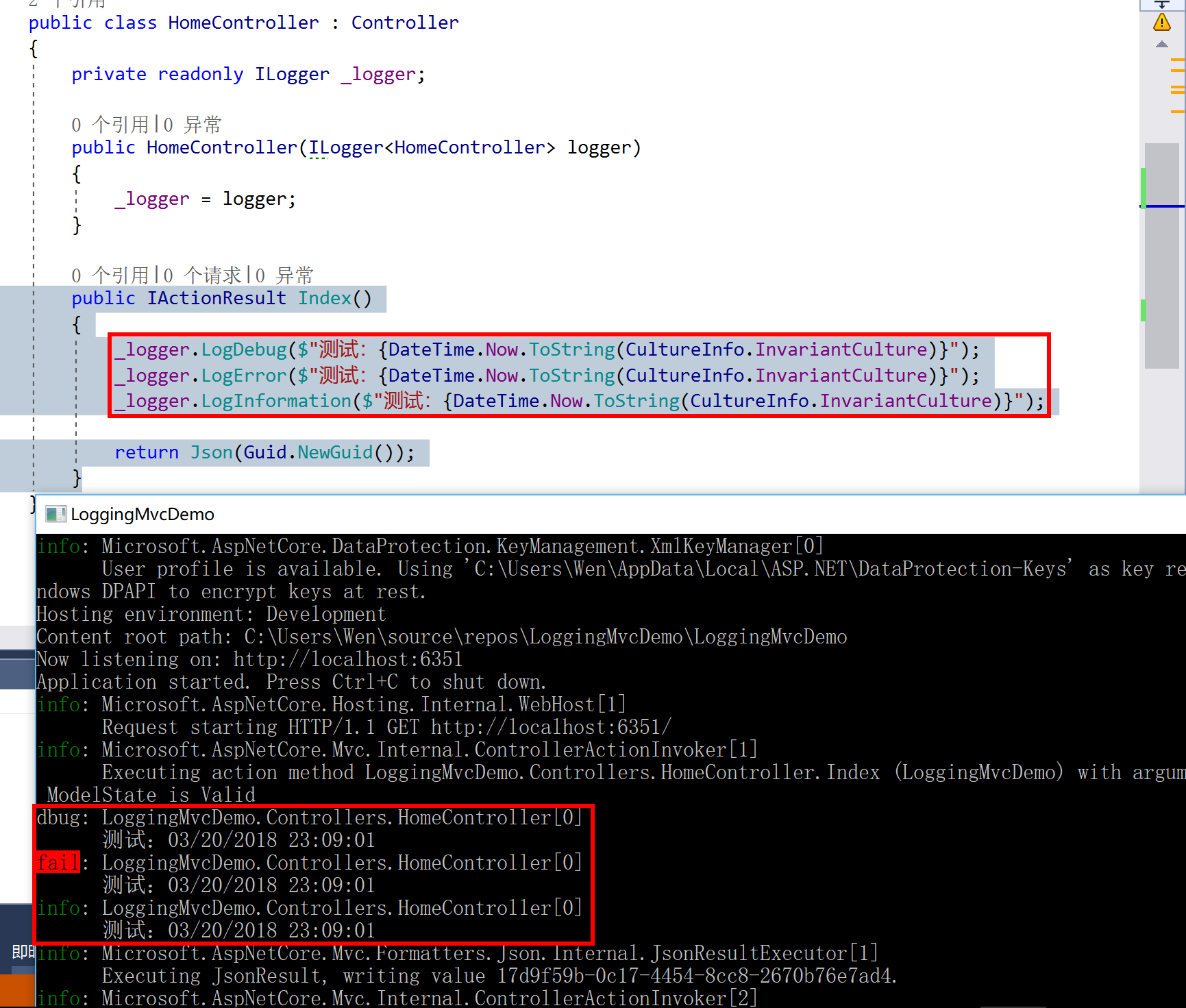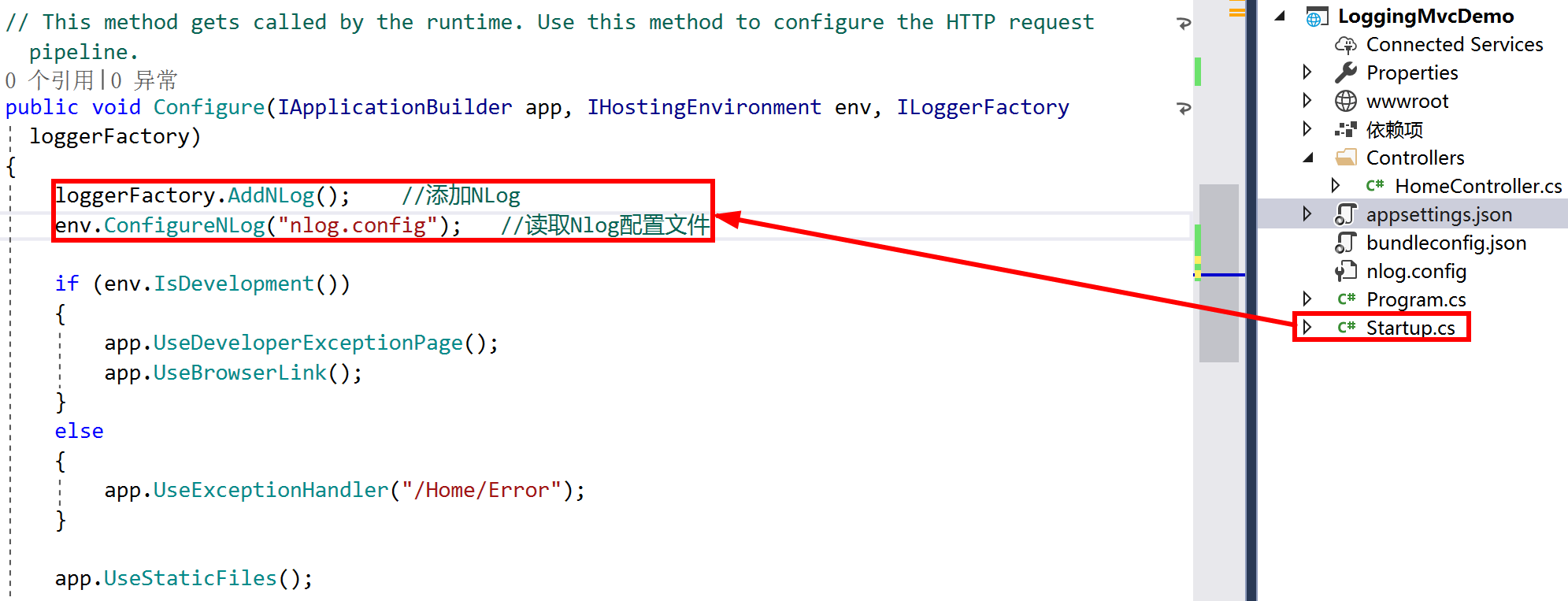在 Mvc 中簡單使用日誌組件 基於 .Net Core 2.0,本文只是蜻蜓點水,並非深入淺出。 目錄 使用內置的日誌組件 簡單過渡到第三方組件 - NLog 使用內置的日誌 下麵使用控制器 HomeController.cs 進行演示。 需要 using Microsoft.Extensions ...
在 Mvc 中簡單使用日誌組件
基於 .Net Core 2.0,本文只是蜻蜓點水,並非深入淺出。
目錄
- 使用內置的日誌組件
- 簡單過渡到第三方組件 - NLog
使用內置的日誌
下麵使用控制器 HomeController.cs 進行演示。
需要 using Microsoft.Extensions.Logging;
方案一:
public class HomeController : Controller { private readonly ILogger _logger ; public HomeController(ILoggerFactory loggerFactory) { _logger = loggerFactory.CreateLogger(typeof(HomeController)); } }
方案二:
public class HomeController : Controller { private readonly ILogger _logger ; public HomeController(ILogger<HomeController> logger) { _logger = logger; } }
方案三:
public class HomeController : Controller { private readonly ILogger _logger ; public HomeController(ILogger logger) { _logger = logger; } }
三種都是通過註入的方式獲取日誌記錄器對象,在過去,我們會自己獨立封裝類似這些 Debug、Info 和 Error 等不同日誌等級的方法,現在我們看看內置的方法是如何使用的?
在 HomeController 內添加 Index() 方法進行測試。
public IActionResult Index() { _logger.LogDebug($"測試:{DateTime.Now.ToString(CultureInfo.InvariantCulture)}"); _logger.LogError($"測試:{DateTime.Now.ToString(CultureInfo.InvariantCulture)}"); _logger.LogInformation($"測試:{DateTime.Now.ToString(CultureInfo.InvariantCulture)}"); return Json(Guid.NewGuid()); }
在輸出結果中我們可以看到,不同日誌的等級在控制臺中會以不同的顏色進行標註。

每種級別的 Log 都有多個方法重載,如 LogInformation() ,示例演示的代碼中使用的是比較簡單一種,也就是最後一種。
// // 摘要: // Formats and writes an informational log message. // // 參數: // logger: // The Microsoft.Extensions.Logging.ILogger to write to. // // eventId: // The event id associated with the log. // // message: // Format string of the log message. // // args: // An object array that contains zero or more objects to format. public static void LogInformation(this ILogger logger, EventId eventId, string message, params object[] args); // // 摘要: // Formats and writes an informational log message. // // 參數: // logger: // The Microsoft.Extensions.Logging.ILogger to write to. // // exception: // The exception to log. // // message: // Format string of the log message. // // args: // An object array that contains zero or more objects to format. public static void LogInformation(this ILogger logger, Exception exception, string message, params object[] args); // // 摘要: // Formats and writes an informational log message. // // 參數: // logger: // The Microsoft.Extensions.Logging.ILogger to write to. // // message: // Format string of the log message. // // args: // An object array that contains zero or more objects to format. public static void LogInformation(this ILogger logger, string message, params object[] args);
其它細節以及詳情,或者希望使用其它日誌組件可參考官方文檔:https://docs.microsoft.com/en-us/aspnet/core/fundamentals/logging/?tabs=aspnetcore2x
簡單過渡到第三方組件 - NLog
Nuget 安裝 NLog.Web.AspNetCore(目前 Nuget 最新為 4.4.1,但是官方的教程卻是 4.5 的,小編使用 4.4.1 進行演示)。如需 4.5+ 可參考官方:https://github.com/NLog/NLog.Web/wiki/Getting-started-with-ASP.NET-Core-2

下麵演示如何將內置的組件簡單的移植到 NLog 中。
先在根目錄創建配置文件 nlog.config,記得將屬性修改成始終複製到目錄:
<?xml version="1.0" encoding="utf-8" ?> <nlog xmlns="http://www.nlog-project.org/schemas/NLog.xsd" xmlns:xsi="http://www.w3.org/2001/XMLSchema-instance" autoReload="true" internalLogLevel="info" internalLogFile="c:\temp\internal-nlog.txt"> <!-- the targets to write to --> <targets> <!-- write logs to file --> <target xsi:type="File" name="allfile" fileName="c:\temp\nlog-all-${shortdate}.log" layout="${longdate}|${event-properties:item=EventId_Id}|${uppercase:${level}}|${logger}|${message} ${exception:format=tostring}" /> <!-- another file log, only own logs. Uses some ASP.NET core renderers --> <target xsi:type="File" name="ownFile-web" fileName="c:\temp\nlog-own-${shortdate}.log" layout="${longdate}|${event-properties:item=EventId_Id}|${uppercase:${level}}|${logger}|${message} ${exception:format=tostring}|url: ${aspnet-request-url}|action: ${aspnet-mvc-action}" /> </targets> <!-- rules to map from logger name to target --> <rules> <!--All logs, including from Microsoft--> <logger name="*" minlevel="Trace" writeTo="allfile" /> <!--Skip non-critical Microsoft logs and so log only own logs--> <logger name="Microsoft.*" maxLevel="Info" final="true" /> <!-- BlackHole without writeTo --> <logger name="*" minlevel="Trace" writeTo="ownFile-web" /> </rules> </nlog>
修改 Startup.cs 類中的 Configure() 方法,其它地方都不需要做出任何修改。
public void Configure(IApplicationBuilder app, IHostingEnvironment env, ILoggerFactory loggerFactory) { loggerFactory.AddNLog(); //添加NLog env.ConfigureNLog("nlog.config"); //讀取Nlog配置文件 //... }

啟動程式,你會發現:

【原文】http://www.cnblogs.com/liqingwen/p/8613538.html
相關的文章:
《[.Net Core] 簡單使用 Mvc 內置的 Ioc》
《[.Net Core] 簡單使用 Mvc 內置的 Ioc(續)》



